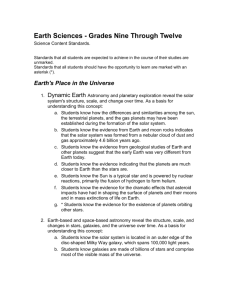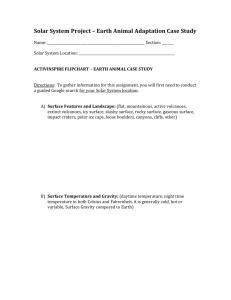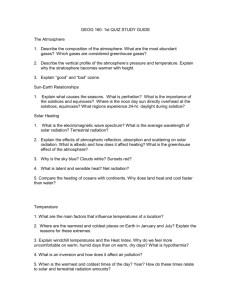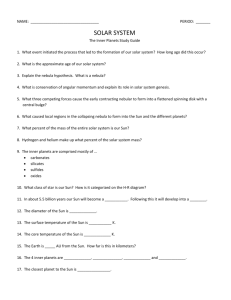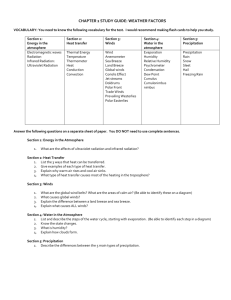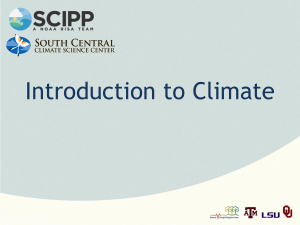Physical Earth Science Semester 2 Final Review –Key 1. The
advertisement
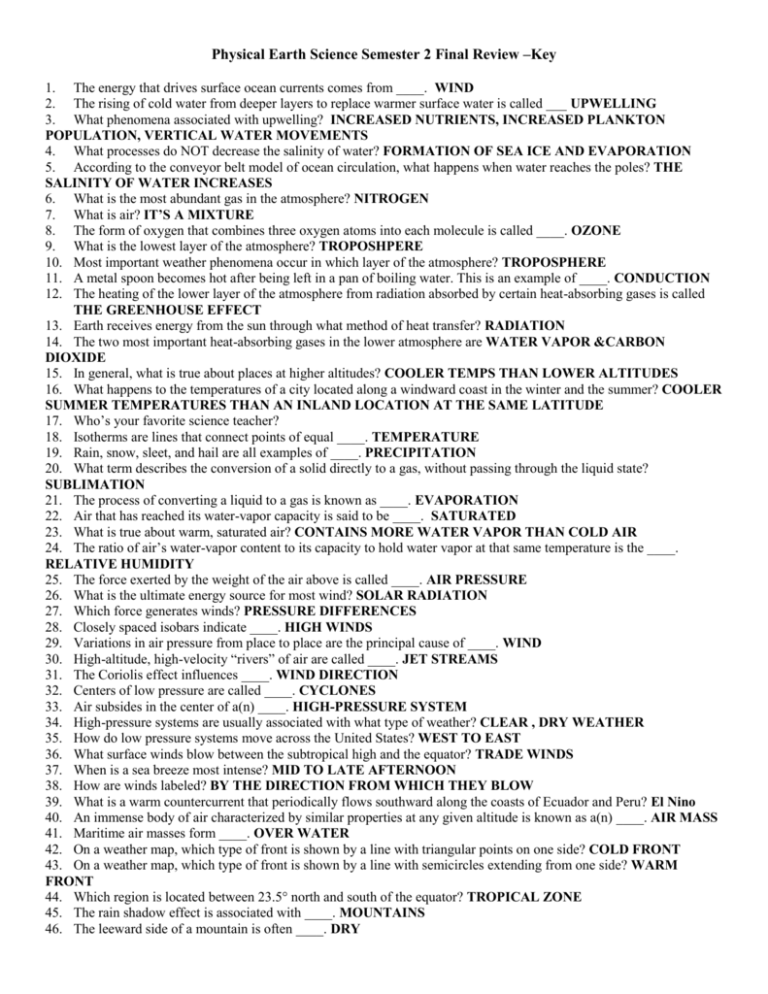
Physical Earth Science Semester 2 Final Review –Key 1. The energy that drives surface ocean currents comes from ____. WIND 2. The rising of cold water from deeper layers to replace warmer surface water is called ___ UPWELLING 3. What phenomena associated with upwelling? INCREASED NUTRIENTS, INCREASED PLANKTON POPULATION, VERTICAL WATER MOVEMENTS 4. What processes do NOT decrease the salinity of water? FORMATION OF SEA ICE AND EVAPORATION 5. According to the conveyor belt model of ocean circulation, what happens when water reaches the poles? THE SALINITY OF WATER INCREASES 6. What is the most abundant gas in the atmosphere? NITROGEN 7. What is air? IT’S A MIXTURE 8. The form of oxygen that combines three oxygen atoms into each molecule is called ____. OZONE 9. What is the lowest layer of the atmosphere? TROPOSHPERE 10. Most important weather phenomena occur in which layer of the atmosphere? TROPOSPHERE 11. A metal spoon becomes hot after being left in a pan of boiling water. This is an example of ____. CONDUCTION 12. The heating of the lower layer of the atmosphere from radiation absorbed by certain heat-absorbing gases is called THE GREENHOUSE EFFECT 13. Earth receives energy from the sun through what method of heat transfer? RADIATION 14. The two most important heat-absorbing gases in the lower atmosphere are WATER VAPOR &CARBON DIOXIDE 15. In general, what is true about places at higher altitudes? COOLER TEMPS THAN LOWER ALTITUDES 16. What happens to the temperatures of a city located along a windward coast in the winter and the summer? COOLER SUMMER TEMPERATURES THAN AN INLAND LOCATION AT THE SAME LATITUDE 17. Who’s your favorite science teacher? 18. Isotherms are lines that connect points of equal ____. TEMPERATURE 19. Rain, snow, sleet, and hail are all examples of ____. PRECIPITATION 20. What term describes the conversion of a solid directly to a gas, without passing through the liquid state? SUBLIMATION 21. The process of converting a liquid to a gas is known as ____. EVAPORATION 22. Air that has reached its water-vapor capacity is said to be ____. SATURATED 23. What is true about warm, saturated air? CONTAINS MORE WATER VAPOR THAN COLD AIR 24. The ratio of air’s water-vapor content to its capacity to hold water vapor at that same temperature is the ____. RELATIVE HUMIDITY 25. The force exerted by the weight of the air above is called ____. AIR PRESSURE 26. What is the ultimate energy source for most wind? SOLAR RADIATION 27. Which force generates winds? PRESSURE DIFFERENCES 28. Closely spaced isobars indicate ____. HIGH WINDS 29. Variations in air pressure from place to place are the principal cause of ____. WIND 30. High-altitude, high-velocity “rivers” of air are called ____. JET STREAMS 31. The Coriolis effect influences ____. WIND DIRECTION 32. Centers of low pressure are called ____. CYCLONES 33. Air subsides in the center of a(n) ____. HIGH-PRESSURE SYSTEM 34. High-pressure systems are usually associated with what type of weather? CLEAR , DRY WEATHER 35. How do low pressure systems move across the United States? WEST TO EAST 36. What surface winds blow between the subtropical high and the equator? TRADE WINDS 37. When is a sea breeze most intense? MID TO LATE AFTERNOON 38. How are winds labeled? BY THE DIRECTION FROM WHICH THEY BLOW 39. What is a warm countercurrent that periodically flows southward along the coasts of Ecuador and Peru? El Nino 40. An immense body of air characterized by similar properties at any given altitude is known as a(n) ____. AIR MASS 41. Maritime air masses form ____. OVER WATER 42. On a weather map, which type of front is shown by a line with triangular points on one side? COLD FRONT 43. On a weather map, which type of front is shown by a line with semicircles extending from one side? WARM FRONT 44. Which region is located between 23.5° north and south of the equator? TROPICAL ZONE 45. The rain shadow effect is associated with ____. MOUNTAINS 46. The leeward side of a mountain is often ____. DRY 48. Increased altitude generally causes lower ____. TEMPERATURES 49. Global winds move warm air toward the ____. POLES 50. Heat and moisture are distributed around Earth by ____ . GLOBAL WINDS 51. What two factors are used to classify climate in the Köppen climate classification system? TEMPERATURE AND PRECIPITATION 52. What factor distinguishes wet tropical climates from tropical wet and dry climates? PRECIPITATION 53. In dry climates, rates of evaporation exceed ____ THE RATE OF PRECIPITATION 54. Which type of climate is characteristic of Antarctica? POLAR 55. How does volcanic ash in Earth’s atmosphere affect solar radiation? INCREASES THE AMOUNT OF SOLAR RADIATION THAT IS REFLECTED INTO SPACE 56. What phenomenon naturally warms Earth’s lower atmosphere and surface? GREENHOUSE EFFECT 57. Which greenhouse gas is the most powerful absorber of radiation emitted by Earth? WATER VAPOR 58. A measure of the total amount of matter an object contains is called ____. MASS 59. What movement of Earth is responsible for night and day? ROTATION 60. What occurs when the moon casts its shadow on Earth? SOLAR ECLIPSE 61. Round depressions on the moon’s surface are called ____. CRATERS 62. Why does the moon have more craters than Earth? WEATHERING AND EROSION DO NOT OCCUR ON THE MOON47. What is the relationship between elevation and climate? HIGHER ELEVATION = COLDER CLIMATE 63. List the Jovian planets. JUPITER, SATURN, URANUS, NEPTUNE 64. List the terrestrial planets. MERCURY, VENUS, EARTH, MARS 65. The most obvious difference between the terrestrial and the Jovian planets is ____. SIZE 66. Which planet has a dense carbon dioxide atmosphere and high surface temperatures? VENUS 67. Which planets do NOT have rings? TERRESTRIAL PLANETS 68. What features on Mars point to the possibility of liquid water on the planet? GULLIES AND STREAMLIKE CHANNELS 69. What color has the longest wavelength? RED 70. Gamma rays, X-rays, visible light, and radio waves are all types of ____. ELECTROMAGNETIC RADIATION 71. Which color has the most energetic photons? VIOLET 72. What does a prism do? SEPARATES VISIBLE LIGHT INTO SEVERAL COLORS 73. A typical incandescent light bulb produces a(n) ____. CONTINUOUS SPECTRUM 74. What will happen to an object’s wavelength as the object moves toward you? THE WAVELENGTH WILL BE SHORTENED 75. Using the Doppler effect, astronomers can determine a star’s ____. MOVEMENT TOWARD OR AWAY FROM EARTH 76. The layer of the sun that radiates most of the light that reaches Earth is the ____. PHOTOSPHERE 77. The outermost layer of the sun is called the ____. CORONA 78. The sun’s surface has a grainy texture produced by numerous bright markings called ____. GRANULES 79. Streams of electrons and protons that shoot out from the sun’s corona make up the solar ____. WIND 80. What are the most explosive events that occur on the sun? SOLAR FLARES 82. Know the various solar features. PHOTOSPHERE, CHROMOSPHERE, CORONA, SUNSPOTS, PROMINENCES, SOLAR FLARES, GRANULES, SOLAR WIND 83. Sunspots appear dark because they are ____. RELATIVELY COOL 84. The source of the sun’s energy is ____. NUCLEAR FUSION 85. Stars of which color have the highest surface temperature? BLUE 86. Stellar distances are usually expressed in what units? LIGHT YEARS 87. The measure of a star’s brightness is called its ____. MAGNITUDE 88. The difference in the brightness of two stars with the same surface temperature is attributable to their ____. SIZES 89. About 90 percent of stars on the H-R diagram are ____. MAIN SEQUENCE STARS 90. Which main-sequence stars are the most massive? BLUE 91. What main-sequence stars are brightest? THE HOTTEST 92. Another name for the interstellar matter that will eventually form a star is ____. NEBULA 93. A star is said to be born when ____. NUCLEAR FUSION BEGINS 94. Massive stars terminate in a brilliant explosion called a ____. SUPERNOVA 95. The sun is a ____. MAIN SEQUENCE STAR 96. What is the next stage in the sun’s life cycle? RED GIANT 97. Our galaxy is called the ____. MILKY WAY 98. Where is our sun located in the Milky Way? WITHIN ONE OF THE SPIRAL ARMS 99. List the types of galaxies. SPIRAL, ELLIPTICAL, IRREGULAR 100.What evidence supports the big bang? COSMIC BACKGROUND RADIATION, EXPANSION OF THE UNIVERSE




